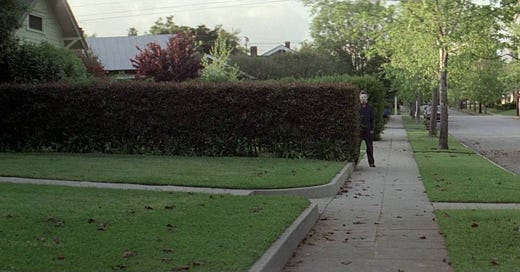The Subversiveness of John Carpenter's Halloween
I don’t like slasher movies. In my youth, I thought they were cheap and gratuitous, and when I got a little older I thought they were sexist and reactionary. Something about watching young women get dismembered with a knife while undressed struck me as pretty gross. I am aware that plenty of people have tried to rehabilitate some slasher flicks from a feminist perspective, but I have not been able to overcome my dislike.
Until now.
Last night I decided to watch the original Halloween from 1978 because it’s spooky season (natch) and I have been on a big John Carpenter kick. (I watched Prince of Darkness last week.) I’d also heard that this film basically kicked off the slasher genre and so as a student of film history I felt an obligation.
Despite the film being 44 years old it scared the shit out of me. It was a mistake to watch it before bed in a dark house, I was glad that my cat came into the bed and lay down on top of me, her incessant purr soothing me.
Beyond providing chills and thrills, I appreciated (as usual) John Carpenter’s artistry, Dean Cundey’s glorious cinematography and lighting, and Jamie Lee Curtis’ acting. Above all, I savored its subversion.
Haddonfield, Illinois, is a stand-in for Everytown middle-class suburbia at what I think of as the suburbs’ apex. We tend to locate that in the 50s, but even more people left cities for suburbs in the 70s. They did so right before gentrification or yuppies, when the city was the place to escape.
In that decade cities evoked fear and crime, things the suburbs were supposed to eliminate. Plenty of 70s films portrayed New York as a dangerous, unredeemable hell hole, from Taxi Driver to Death Wish. Fortress Suburbia has always promised an escape from the urban world and its supposed problems. That’s why every time a mass shooting happens in such places people reflexively say “this isn’t supposed to happen here” as if there are places where it IS supposed to happen.
The “evil” as Dr Loomis calls Michael Myers, comes from within the suburbs, not from without. He stabs his own sister to death when still a child, a seemingly senseless act and a horrific violation of the family, the thing the suburbs are supposed to protect. When Myers escapes from the psychiatric hospital to commit mayhem he doesn't go to the big city, he goes back home, to the suburbs.
While the suburbs have lost some of their allure in the ensuing decades, they still maintain their fortress mentality. Suburbanites in New Jersey and Long Island have ridiculously well-funded local police departments, there to keep any outsiders from stepping in. They maintain restrictive zoning practices and fight any kind of affordable or dense housing that might bring new kinds of people into their communities. Suburbanites still cling to the idea that they can somehow prevent interacting with the wider world and save themselves in the process.
It’s all based on a false myth of the suburbs as a place of refuge and harmony and the city as a den of iniquity. Halloween gets at the darkness lurking in suburbia, and the porousness of the fortress walls. Micheal Myers shows that there’s no place where “it’s not supposed to happen” because the worst can happen anywhere with no explanation. That’s what truly makes it a scary movie.



